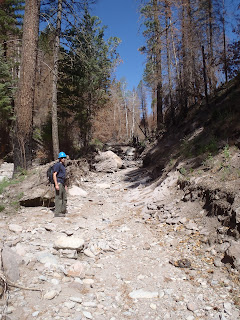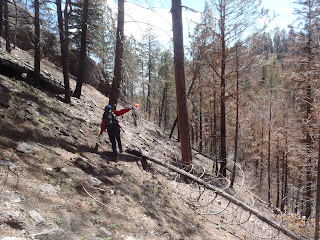The trip was severely altered on June 28, 2000. About 1.5 inches of rain fell on the upper watershed that 6 weeks before had been intensely burned by the Cerro Grande fire. In less that an hour, a section of trail was transformed into a 6-foot deep trench.
 |
| In July 2000, June Fabryka-Martin and Eric Peterson survey the damage brought by the June 2000 storm in the Valle Canyon Watershed |
 |
| Approximately the same spot of the 2000 photo above in May 2011, post-Las Conchas Fire |
 |
| The old road covered by snowy rocks in November 2011. The trail followed the old road here. |
 |
| A mini-dozer called a Sweco graded the lower stretch of the Valle Canyon Trail in April 2011 |
 |
| Lynn Bjorklund gracefully balances on a steep sideslope while laying out the Valle Canyon bypass route in May 2012. |
The bypass route was a difficult task, but the crew rose to the challenge and created a legacy project. The trail has two switchbacks to maintain an overall 5% grade as it ascends and descends the slope above the post-fire erosion channel.
 |
| The lower switchback on the bypass route |
 |
| The trail corridor traverses a steep slope. The grades are reasonable, but there are several trees close to the trail that will be a problem for mountain bike riders. |
Above the YCC crew's bypass route, the trail returns to its former route along the old road. Sections are washed out, overgrown, or rocky as they pass through the post-fire flood zone. But the entire route is open and easy to follow to the Valles Caldera fence. The uppermost half mile of trail is still intact.
 |
| Makeshift crossings, debris flow drainage cuts, and narrow trail treads mark the upper 1.5 miles of the Valle Canyon Trail. |
UPDATE, November 2012: After three intense summer/fall storms, the trail is holding up very well. Users are wearing in the tread and the trip up the canyon is less rough than it was right after it was rebuilt. In late October, a group of mountain bike riders improved the upper switchback by moving heavy rocks and increasing the turn radius. It's pretty sweet now.
Cañon de Valle Trail at EveryTrail
EveryTrail - Find the best Hiking in New Mexico







